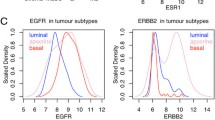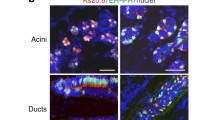Summary
A chemically defined culture medium was developed to support the growth of two distinctly different types of normal human breast epithelial cells (HBEC) derived from reduction mammoplasty. Type I cells expressed luminal epithelial cell markers and were deficient in gap junctional intercellular communication (GJIC), whereas Type II cells expressed basal epithelial cell markers and were efficient in GJIC. In this study, we examined and compared the growth factor and hormone requirements of these two types of cells and a series of cell lines that were obtained by sequential transfection with SV40 DNA (extended lifespan, nontumorigenic), treatment with 5-bromodeoxyuridine (BrdU)/black light (immortal and weakly tumorigenic), and infection of a virus carrying the neu oncogene (highly tumorigenic). Growth of Type I cells was inhibited by withdrawing epidermal growth factor (EGF), hydrocortisone (HC), or insulin (INS) from the culture media, but was enhanced by fetal bovine serum (FBS) supplementation. Growth of Type II cells was inhibited by withdrawal of EGF, HC, or INS from the media, and was inhibited by FBS supplementation. Withdrawal of human transferrin (HT) or 17β-estradiol (E2) from the media did not alter the growth of Type I or Type II cells. SV40 transfected Type I cell lines still required EGF, HC, or INS for optimal growth. However, the highly tumorigenic cell line did not show a growth dependence on EGF, HC, or INS but did appear to require HT and 3,3′,5-triiodo-D.L. thyronine (T3) for optimal growth. In addition, FBS stimulated the growth of these cell lines. Thus, this study shows that Type I HBEC are distinctly different from Type II HBEC in growth response to FBS and that neoplastically transformed Type I cells could become growth factor and hormone independent.
Similar content being viewed by others
References
Balakrishnan, A.; Cramer, S.; Bandyopadhyay, G. K., et al. Differential proliferative response to linoleate in cultures of epithelial cells from normal human breast and fibroadenomas. Cancer Res. 49:857–862; 1989.
Band, V.; Sager, R. Distinctive traits of normal and tumor-derived human mammary epithelial cells expressed in a medium that supports long-term growth of both cell types. Proc. Natl. Acad. Sci. USA 86:1249–1253; 1989.
Band, V.; Zajchowski, D.; Kulesa, V., et al. Human papilloma virus DNAs immortalize normal human mammary epithelial cells and reduce their growth factor requirements. Proc. Natl. Acad. Sci. USA 87:463–467; 1990.
Bartek, J.; Bartkova, J.; Kyprianou, N., et al. Efficient immortalization of luminal epithelial cells from human mammary gland by introduction of simian virus 40 large tumor antigen with a recombinant retrovirus. Proc. Natl. Acad. Sci. USA 88:3520–3524; 1991.
Bartek, J.; Bartkova, J.; Lalani, E.-N., et al. Selective immortalization of a phenotypically distinct epithelial cell type by microinjection of SV40 DNA into cultured human milk cells. Int. J. Cancer 45:1105–1112; 1990.
Berthon, P.; Goubin, G.; Dutrillaux, B., et al. Single-step transformation of human breast epithelial cells by SV40 large T oncogene. Int. J. Cancer 52:92–97; 1992.
Boyce, S. T.; Ham, R. G. Calcium-regulated differentiation of normal human epidermal keratinocytes in chemically defined clonal culture and serum-free serial culture. J. Invest. Dermatol. 81:33S-40S; 1983.
Buehring, G. C. Culture of human mammary epithelial cells: keeping abreast of a new method. J. Natl. Cancer Inst. 49:1433–1434; 1972.
Chang, C. C.; Boezi, J. A.; Warren, S. T., et al. Isolation and characterization of a UV-sensitive hypermutable aphidicolin-resistant Chinese hamster cell line. Somatic Cell Genet. 7:235–253; 1981.
Chang, S. E.; Keen, J.; Lane, E. B., et al. Establishment and characterization of SV40-transformed human breast epithelial cell lines. Cancer Res. 42:2040–2053; 1982.
Chu, E. H. Y.; Sun, N. C.; Chang, C. C. Induction of auxotrophic mutations by treatment of Chinese hamster cells with 5-bromodeoxyuridine and black light. Proc. Natl. Acad. Sci. USA 69:3459–3463; 1972.
Dotto, G. P.; Moellmann, G.; Ghosh, S., et al. Transformation of murine melanocytes by basic fibroblast growth factor cDNA and oncogenes and selective suppression of the transformed phenotype in a reconstituted cutaneous environment. J. Cell Biol. 109:3115–3128; 1989.
Emerman, J. T.; Wilkinson, D. A. Routine culturing of normal, dysplastic and malignant human mammary epithelial cells from small tissue samples. In Vitro Cell. Dev. Biol. 26:1186–1194; 1990.
Engel, L. W.; Young, N. A. Human breast carcinoma cells in continuous culture: a review. Cancer Res. 38:4327–4339; 1978.
Ethier, S. P.; Summerfelt, R. M.; Cundiff, K. C., et al. The influence of growth factors on the proliferative potential of normal and primary breast cancer-derived human breast epithelial cells. Breast Cancer Res. Treat. 17:221–230; 1990.
Garcia, I.; Brandt, D.; Weintraub, J., et al. Loss of heterozygosity for the short arm of chromosome 11(11p15) in human milk epithelial cells immortalized by microinjection of SV40 DNA. Cancer Res. 51:294–300; 1991.
Hammond, S. L.; Ham, R. G.; Stampfer, M. R. Serum-free growth of human mammary epithelial cells: rapid clonal growth in defined medium and extended serial passage with pituitary extract. Proc. Natl. Acad. Sci. USA 81:5435–5439; 1984.
Kao, C. Y.; Nomata, K.; Oakley, C. S., et al. Two types of normal human breast epithelial cells derived from reduction mammoplasty: phenotypic characterization and response to SV40 transfection. Carcinogenesis 16:531–538; 1995.
Koukoulis, G. K.; Virtanen, I.; Korhonen, M., et al. Immunohistochemical localization of integrins in the normal, hyperplastic, and neoplastic breast. Am. J. Pathol. 139:787–799; 1991.
Li, I. C.; Chang, C. C.; Trosko, J. E. Thymidylate synthetase gene as a quantitative mutation marker in Chinese hamster cells. Mutat. Res. 243:233–239; 1990.
O’Hare, M. J.; Ormerod, M. G.; Monaghan, P., et al. Characterization in vitro of luminal and myoepithelial cells isolated from the human mammary gland by cell sorting. Differentiation 46:209–221; 1991.
Petersen, O. W.; Deurs, B. Growth factor control of myoepithelial-cell differentiation in cultures of human mammary gland. Differentiation 39:197–215; 1988.
Pittelkow, M. R.; Scott, R. E. New techniques for the in vitro culture of human skin keratinocytes and perspectdives on their use for grafting of patients with extensive burns. Mayo Clin. Proc. 61:771–777; 1986.
Rudland, P. S.; Ollerhead, G.; Barraclough, R. Isolation of simian virus 40-transformed human mammary epithelial stem cell lines that can differentiate to myoepithelial-like cells in culture and in vivo. Dev. Biol. 136:167–180; 1989.
Shay, J. W.; Van Der Haegen, B. A.; Ying, Y., et al. The frequency of immortalization of human fibroblasts and mammary epithelial cells transfected with SV40 large T-antigen. Exp. Cell Res. 209:45–52; 1993.
Smith, H. S.; Wolman, S. R.; Dairkee, S. H., et al. Immortalization in culture: occurrence at a late stage in the progression of breast cancer. J. Natl. Cancer Inst. 78:611–615; 1987.
Soule, H. D.; Vazquez, J.; Long, A., et al. A human cell line from a pleural effusion derived from a breast carcinoma. J. Natl. Cancer Inst. 51:1409–1416; 1973.
Stampfer, M.; Hallowes, R. C.; Hackett, A. J. Growth of normal human mammary cells in culture. In Vitro 16(5):415–425; 1980.
Stocking, C.; Kollek, R.; Bergholz, U., et al. Long terminal repeat sequences impart hematopoietic transformation properties to the myeloproliferative sarcoma virus. Proc. Natl. Acad. Sci. USA 82:5746–5750; 1985.
Taylor-Papadimitriou, J.; Shearer, M.; Tilly, R. Some properties of cells cultured from early-lactation human milk. J. Natl. Cancer Inst. 58:1563–1571; 1977.
Taylor-Papadiminiou, J.; Stampfer, M.; Bartek, J., et al. Keratin expression in human mammary epithelial cells cultured from normal and malignant tissue: relation to in vivo phenotypes and influence of medium. J. Cell Sci. 94:403–413; 1989.
Trask, D. K.; Band, V.; Zajchowski, D. A., et al. Keratins as markers that distinguish normal and tumor-derived mammary epithelial cells. Proc. Natl. Acad. Sci. USA 87:2319–2323; 1990.
Van Der Haegen, B. A.; Shay, J. W. Immortalization of human mammary epithelial cells by SV40 large T-antigen involves a two step mechanism. In Vitro Cell. Dev. Biol. 29A:180–182; 1993.
Author information
Authors and Affiliations
Rights and permissions
About this article
Cite this article
Kao, CY., Oakley, C.S., Welsch, C.W. et al. Growth requirements and neoplastic transformation of two types of normal human breast epithelial cells derived from reduction mammoplasty. In Vitro Cell.Dev.Biol.-Animal 33, 282–288 (1997). https://doi.org/10.1007/s11626-997-0048-8
Received:
Accepted:
Issue Date:
DOI: https://doi.org/10.1007/s11626-997-0048-8




